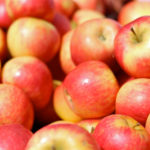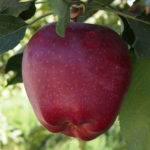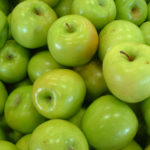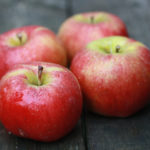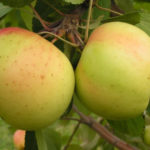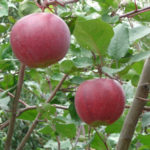Apple variety Alesya
Breeders from all over the world are engaged in breeding hardy and resistant apple trees. For example, Belarusian scientists set a very high bar for themselves, trying to combine winter hardiness, disease resistance, productivity, and, of course, high taste in one variety. And long-term experiments bring excellent results. One of them was the appearance of a ruddy beauty - the apple tree Alesya. The novelty appeared in the Belarusian Research Institute of Fruit Growing. The authors were a group of scientists: G.K. Kovalenko, V.G. Kovalenko, D.V. Grakovich. As parental forms used Belarusian raspberry and Banana. Both varieties belong to the Belarusian selection and from them Alesya inherited the best qualities, the main of which is scab resistance. Another undoubted plus of this variety is the ability of the crop to retain marketability and taste for an unusually long time. The recognition of high characteristics was confirmed by the introduction of a new variety into the State Register of Varieties of Belarus in 1999. The applicant was RUE “Institute of Fruit Growing”. Areas of admission to cultivation: Brest, Vitebsk, Gomel, Grodno, Minsk, Mogilev. This successful species was also included in the State Register of Breeding Achievements of Russia, albeit a little later - in 2002. It has been on state testing since 1989, the applicant and originator was the RNPD Unitary Enterprise Institute of Fruit Growing. There are only two regions of admission in the Russian Federation, but they are quite large: North-West and Central. Despite the fact that Alesya is a young culture, many Russian gardeners saw in it a very promising variety, which in many respects is capable of surpassing domestic ones. But in the Urals and Siberia, growing problems can arise. They are primarily due to the fact that the late harvest simply does not have time to ripen in a short growing season.
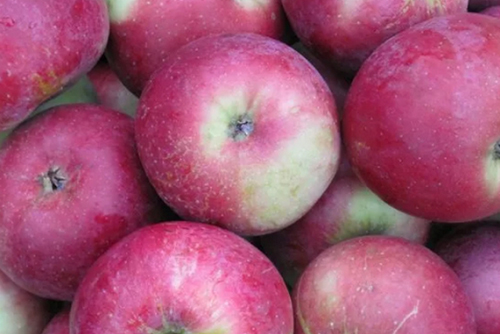
Description
Our heroine is a slowly growing tree, but in the first year of her life she manages to grow by almost a meter. The final height is usually limited to three or four meters. The compactly located medium-branching shoots create an openwork, not too dense crown, the rounded outlines of which add even more attractiveness to the appearance. The neat tree belongs to the spur type, which makes it much easier to care for. Skeletal branches of medium strength extend from the trunk at right angles, which creates a strong fusion of wood. Shoot-forming ability is average. Shoots are straight, above average length and thickness, covered with light brown bark. The ends of the shoots are directed upwards. Lentils are light, small. The foliage is good. Leaves are medium in size, dark green, ovoid, the apex is short, gradually sharpening, the base is rounded, the edges are serrated. The leaf blade is slightly concave, the surface is dull, medium-wrinkled, the nerve is moderately pronounced. Petiole of regular length, thick, light green. The leaf is placed at an acute angle to the shoot. Stipules are small, clavate. Buds are medium in size, conical in shape, brown, pubescent, growing, pressing against the shoot. Excitability of the kidneys is high. The flowers are medium-sized, white-pink in color. Duration of flowering is 8 - 12 days. Pollen viability is 52 - 75%. The crop is placed very tightly on the branches. The type of fruiting is predominantly ringed, which reduces growth processes.
Apples are visually attractive, one-dimensional, medium or above medium in size. But this indicator depends on the stock, for example, on a weakly grown stock 62−396, the weight of the fruit is slightly less than on a vigorous one. The usual weight is 140 - 180 g. The shape is flat-round, leveled. The funnel is of medium depth, wide, with traces of rustiness. The saucer is shallow, of medium width, slightly folded. The calyx is closed, the subacheal tube is small, conical.The heart is medium, rounded, occupies the central part of the fetus. The seed chambers are half-open, not too large. The axial cavity is lanceolate, medium in size. Seeds are dark brown, ovoid, with a sharply defined spout. There are 8-10 of them in one apple. The peduncle is thick, straight, not long. The skin is not thick, elastic, firm, smooth and shiny, slightly oily to the touch. Glaucous wax coating, insignificant. The main color is greenish-yellow, the integumentary color spreads almost over the entire surface in the form of a blurred red blush. Subcutaneous points are light, in small quantities. The pulp is white, fine-grained, juicy, with a moderate aroma. The taste is good, sweet and sour. Gardeners say that ripe fruits can be taken in no hurry to remove from the tree, they are able to gain even more sweetness and increase the volume, however, this process cannot be carried away, otherwise you can lose the harvest. Assessment of tasters from the State Register of 4.3 points. According to other sources, the taste is rated at 5.0 points. 100 g of pulp contains: 13.4% dry matter, 6.96 - 8.27% sugars, 7.9 - 11.9 mg vitamin C.
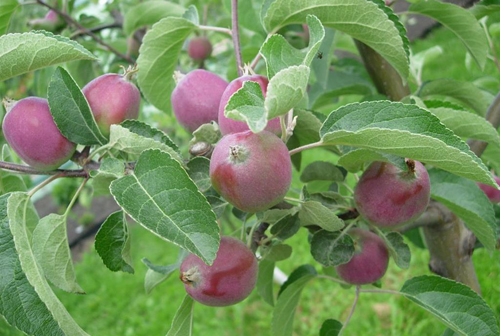
Characteristics
- The early maturity of the Belarusian Alesya is not inferior to many foreign varieties. On rootstock 62-369, it enters the fruiting season as early as 3-4 years after planting with a one-year seedling;
- focusing on the timing of ripening, the State Register classifies our hero as a late winter species. Harvesting maturity occurs in late September - early October. As already noted, the fruits of the culture can be removed the very last in the garden, especially since after ripening they stay on the branches for a long time. The harvested crop must be allowed to mature so that the apples can accumulate more sugar and acquire their characteristic taste conditions. Therefore, the consumer period will not begin until December;
- annual yield, frequency in fruiting was not noted;
- productivity is good, increasing every year. Of course, it is still difficult to judge the possibilities of a young culture, but the State Register gives the following indicators - in the Central Black Earth District, the yield was 60 c / ha. According to other data, the yield of five-seven-year-old trees is about 22.0 kg, from nine-year-old trees are harvested already 29-32 kg;
- there is no data from the State Register regarding frost resistance. But breeders claim a high ability of the variety to withstand low temperatures in winter. In this component, our heroine surpasses even the famous Antonovka. True, there is information that in the Yaroslavl region in the winter of 2016 - 2017, when an absolute minimum of minus 39.2 ° C was recorded in early January, freezing of the apple tree was 3.0 points out of 5.0 possible. But at the same time, a good ability to recover the variety after an unfavorable period was noted;
- this culture has a right to be proud of its immunity. The fact is that Belarusian gardens suffer very much from scab, so the main task of breeders is to instill in a new culture of high resistance to this disease, but not only to it. Our heroine has a high resistance to scab, which is due to polygenicity. In addition, the variety perfectly resists powdery mildew, which is confirmed by many gardeners. Thanks to these qualities and timely spring prevention, at the end of the season it will be possible to get high-quality and environmentally friendly fruits;
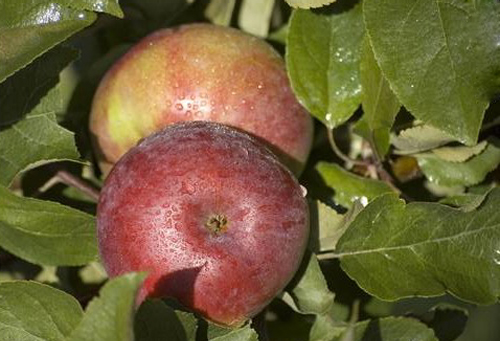
- there is also a good ecological resistance of the plant to various unfavorable environmental factors. The culture is capable of tolerating short-term drought;
- transportable performance at a high level;
- in terms of storage duration, Alesya is one of the leaders among winter crops. In the refrigerator, the crop can be stored until April or May, without losing its presentation and taste;
- the method of appointment is the dining room. The fruits are consumed in their natural form. The period of consumption falls on the moment when the bulk of the stored apples have already been eaten. In addition, the harvest is processed into tasty and healthy preparations - jam, jam, applesauce, baking stuffing, juice and compote.
Pollinators
In the State Register there is no information about the degree of self-fertility of our heroine. But some sources indicate that Alesya is a self-fertile culture. In order for her to tie a quality crop, you need the right pollinators. At the same time bloom with her: Breburn, Florina, Bogatyr, Red Chief, Cameo, Imrus, Pinova, Raika.
Agrotechnics
In warm regions, it is more expedient to plant the Ales apple tree in the fall, in cool regions - in the spring. In order for the fruits to gain more sugar and acquire a characteristic bright color, sunny areas should be selected for planting. The culture develops well on highly structured, nutrient soils with neutral acidity. For our heroine, loam, ordinary chernozem, gray soil, chestnut soils are quite suitable. An adult tree is watered infrequently, but so that the soil is moistened to a depth of at least 50 cm. Taking into account precipitation during the growing season, the apple tree is moistened at least 3 times, pouring 50-60 liters of water under the tree. By the way, such a large volume of water is best divided into two applications - morning and evening, this will allow the water to completely and to the desired depth moisten the area in the near-stem circle. In a hot period, the frequency of watering should be increased. The variety responds well to the alternation of mineral fertilizers with organic ones. Preventive treatment is necessarily carried out in the spring, before the kidneys open. A not too thickened crown evenly transmits sunlight, however, pruning should be carried out annually. In the spring, as a rule, broken, frozen branches or branches growing deeper into the crown are removed. Sanitary pruning is done as needed.
Apple tree Alesya is one of the most successful varieties of Belarusian selection. The plant is short, neat, fits into small spaces and allows for easy harvesting. Yes, and it is a joy to care for such a plant, the crown is not too thickened and it will not require frequent thinning pruning. Non-sprinkling of fruits is exactly what is needed for summer residents who visit their gardens only on weekends. The culture has a high frost resistance, sufficient for cultivation in central Russia. Excellent scab resistance allows for fewer treatments and an environmentally friendly product. The combination of excellent qualities makes Alesya a promising variety for setting up industrial orchards and for involving in breeding to create new apple varieties. Another advantage of our heroine is her, one might say, record keeping quality - a rare culture can boast that its fruits will last almost until the end of spring without losing their presentation and taste. The harvest is used in a universal way, but its main purpose is to use it in its natural form. Despite the fact that the variety is young, domestic gardeners have already fallen in love with it. And entering into the State Register is a kind of quality mark of our heroine. During the period of cultivation of this apple, no critical shortcomings were identified.
